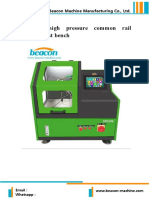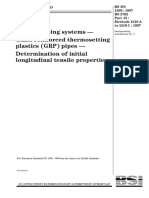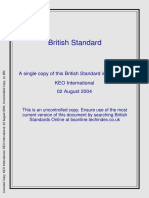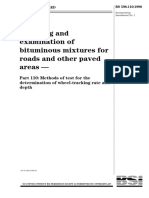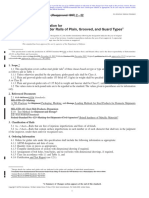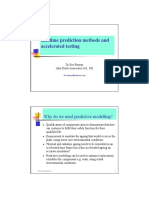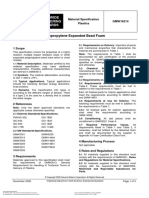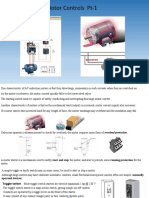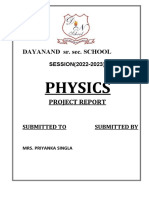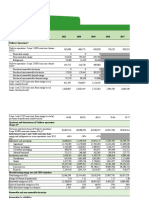DIN 53438 - en - 1984-06-01 - 13161
DIN 53438 - en - 1984-06-01 - 13161
Uploaded by
Lucas MlbCopyright:
Available Formats
DIN 53438 - en - 1984-06-01 - 13161
DIN 53438 - en - 1984-06-01 - 13161
Uploaded by
Lucas MlbOriginal Title
Copyright
Available Formats
Share this document
Did you find this document useful?
Is this content inappropriate?
Copyright:
Available Formats
DIN 53438 - en - 1984-06-01 - 13161
DIN 53438 - en - 1984-06-01 - 13161
Uploaded by
Lucas MlbCopyright:
Available Formats
DC 620.22 : 620.193.9 : 636.
46 DEUTSCHE NORM June 198
‘Testing of combustible materials
DIN
Response to ignition by a small flame
Surface ignition 53,438
Prüfung von brennbaren Werkstoffen; Verhalten beim Beflammen mit einem Brenner; Supersedes April 1917 edition
Flächenbeflammung
In keeping with currentpractice in Standards published by the International Organization for Standardization IISOJ,
a comnm has been used throughout as the dezimal marker.
Dimensions in mm
1 Field of application 4.2 In the tert area (laboratorv) and exhaust hood, the
This Standard specifies the method of test for determi- ambient temperafure shall, at least at the Stert of each
ning the response of maferials tO surface ignition, refer- test, lie between 18 and 28”Cas specified in DIN 50 014.
red tO in brief es method F. See DIN 53 438 Part 1,
DIN 50 050 and DIN 50 051 for general information, 4.3 Measure the thickness of the test pieces on the
erplanatory “oter, concepts and apparatus. See central longitudinal axir et distances of 40, 100 and
DIN 53 438 Part 2 for edge ignition (methcd K). 160 mm from their lower edges to * 0.1 mm, or tO
* 0.01 i-nm in the case of test pieces lesr than 1 mm thick.
2 Test pieces Lay the test piece in the two-part frame (sec DIN 53 438
Part 1, June 1984 edition, subclause 4.1.3) so that the
2.1 Take or prepare 10 tert pieces (sec subclause 4.1) lower edge of the test piece coincides with the lower
from the product tO be tested. In the case of anisotropic edge of the frame (sec figure). Join the two Parts of the
products, take note of the direction of rampling and frame using threaded or rpring Clips and suspend the
include this information in the test report. frame vertically from the suspension device positio&d in
the test chamber.
2.2 The test pieces shall be 230 mm in length by 90 mm
With the burner (sec DIN 53 438 Part 1, June 1984
in width. Their thickness Shell depend on the rpecifice-
edition, subclaure 4.1.1) set in the vertical position. ad-
tions for the product concerned or shall be agreed upon.
just the flame tO a height of 20 mm. With the flame et
Use only test pieces the thickness of which does not de-
this height. leave the burner t~ burn for et least ooe
viate from the thickness of all other tert pieces by more
minute Prior tO commencing the test, readjusting the
than * 10% at any Point. If the given permissible devi-
height, if necessary, et the end of this period. Then incline
ation is exceeded. the fest report shall contain a nute to
the burner through 45’ and close the test chamber.
that effect.
2.3 Make gauge markr on each of the test pieces et the 4.4 Slide the burner towards the test piece so that the
following distances from what will be the lower edge flame impinges on the test piece in the centre of the
when the test piece is in the test Position: 40 mm (lower lower gauge mark. The distance between the front edge
gauge mark) and 190mm (upper gauge mark). of the stabilizer and the surface of the test piece shall be
5mm (See figurel.
3 Conditioning of test pieces
Prior tO testing. the tert pieces shall be rtored in a
DIN 50 014 - 23/50-2 Standard atmosphere. The dura-
tion of the conditioning period shall depend on the spec-
ification for the product under tert. or shall be agreed
upon. If noother rpecificationobtainr. thenconditioning
shall last for not less than 24 h.
4 Procedure
4.1 The tert shall be carried Out on five tert pieces. If
noclear classification in accordance with subclause 5.2
ie possible, the test shall be repeated on five further test
pieces. Figure.
Continued on pages 2 and 3
BeYth“erlag GmbH.Berlhn30.tlas BXCIYW.aalenght6f0. c3*rlnmSfandard?i
,DIN-Normen, DIN 53 438 Part 3 Eng/. Price group 5
08.85 Saba NO. 0105
Page 2 DIN 53 438 Part 3
Apply the flame to the test piece for 15 seconds and greater shall be rounded to within 0.1 mm, and thick-
then withdraw the burner. Take particular care to ensure nesses less than 1 mm shall be rounded to within 0.01 mm.
that no disturbing draughts arc created ss a result. (For example: F 1/3,5 mm signifies class F 1 (face igni.
Measure the burning time (sec DIN 53 438 Pait 1 for tion) for a test piece with an average thickness of 3.5 mm.)
concept) from the initial application of the flame until
5.2 Evaluation in accordance with subclause 5.1 shall
the flame on the test piece ceases to burn, or until the
be subject to the following specifications:
tip of the flame on the burning fest piece reaches the
upper gauge mark. If the fest piece continues to glow 1 If all test pieces of a material tan be astigned to the
after the flame is extinguished. mearure the afterglow same class, the material shall be said to belang to that
time (sec DIN 53 438 Part 1 for concept) from the ex- Cl%S.
tinction of the flame on the test piece until gtowing 2 If two of <he five test pieces of a material arc to be
ceases. Any particular observations during the course of assigned to an inferior class, the material shall be said
the test shall be noted in the test report: these may in- to belang to the inferior class.
clude formation of smoke and soot. material falling and 3 If one of the five test pieces is tobe assigned to an
dripping from the test piece and whether such material inferior class. the tert shall be repeated on five new
continues to burn on reaching the floor of the chamber, test pieces of the sarne material. If retesting results in
appearance of the malten edge (e.g. whether a frame- one or more test pieces being assigned to an inferior
work is leftl, burning on both sides or just on one, class, the material nhall be Said to belang to the in-
shrinkage of the test piece away from the flame. burn- ferior class.
ing of a hole through the test piece. extent of burning.
Then assessthe tert piece in accordance with clause 5 5.3 Average the burning times of the tost pieces tested
and assign it to a class. in accordance with rubclause 4.4, and stste the mean
value. in seconds, rounded to the nearest second, in the
test report as the mean burning time of the material.
4.5 The frame and the supension device shall have
cooled to an ambient fernpersture of 18 to 28OC. aS Average the afterglow times of the test pieces tested in
specified in DIN 50 014, before a subsequent test rnay accordance with subclause 4.4 and state the mean value,
be commenced. in seconds, rounded to the nearest second. in the test
report as the mean afterglow time of the material.
5 Assessment and evaluation 6 Test report
5.1 Esch of the test pieces tested as described in sub- The test report shall refer to this Standard and include
clause 4.4 shall be assessed in accordance with rhe table the following particulars:
below: al type and designation of the product (material)
tested;
Evaluation Cl%
bl method and date of production of the fest pieces.
indicating the direction of sampling, if relevant;
The flame tip on the burning test piece.does cl conditioning of the tost pieces:
notwach the upper gauge mark (the flame is F 1
d) statement of which surface was tested, or whether
extinguished beforehand)
both were tested;
e) mean thickness obtained from measuring all tost
The flame tip on the burning test piece pieces in accordance with subclause 4.3; minimum
reaches the upper gauge mark in 20 seconds F2 and maximum thicknesses measured;
or langer f) mean burning time;
gl mean afterglow time;
The flame tip on the burning test piece
F3 h) class. indicating the mean measured thickness, as
waches the upper gauge mark in less than
specified in subclause 5.1;
20 secondr
iJ Point of flame impingence in the case of test pieces
thicker than 3 mm:
The mean thickness of the test piece shall be suffixed jl particular observations made during the test es de-
to the indication of the class, the two values being se- scribed in subclause 4.4;
parated by an oblique stroke. Thicknesses 1 mm or kl date of test.
DIN 53 438 Part 3 Page 3
Standards referred to
DIN 50014 Atmospherer and fheir technical application; Standard atmorpherer
DIN 50 050 Materials testing; burning behaviour of materials; flame test chamber
DIN 50 051 Materials testing; burning behaviour of materials; burner
DIN 51 622 Liquid gases; propane, propene. butane. butene and their mixtures; quality requirements
DIN 53 436 Part 1 Testing of comburtible materials; response to ignition by a small flame; general data
DIN 53 439 Part 2 Testing of combustible materials; response to ignition by a small flame; edge ignition
Other relevant Standards
DIN 54332 Terting of textiles; determination of the burning behaviour of textile floor coverings
DIN 54 336 Terting of textiles: determination of the burning behaviour, vertical method; edge ignition
Previous editions
DIN 53 436: August 1970
DIN 63 436 Part 3: April 1977
Amendments
The following amendments have been made in comparison with the April 1977 edition:
a) the requirements in subclaures 4.3 and 5.2 have been made more precise;
bl a new subclause. subclause 5.3, has been incorporated;
cl the Standard has been editorially revised.
Explanatory notes
Experience har confirmed that it is necessary to define both edge and surface ignition in order to eszess combustibility
characteristics. After careful consideration, it har been decided not to include in the present Standard methodr for the
determination and evaluation of the loss of flaming material through dripping, rince a clarsification of materials in this
respect may prerent rerious Problems or even be misleading.
The test procedures specified in this Standard were initially developed for plastics and have been tested experimentally.
The method is, however. also appropriate for other materials, such es wood, paper etc. Similar Standards have been drawn
up for textiles lsee DIN 54 332 and DIN 54 336).
Since test Standards arc intended to serve es a suitable basis for legal requirements, for production control and for testing
products during development and in “ne, both methods of test have been given a classification system.
lt is now internationally accepted that the results of combustibility tests performed on products or materials under
controlled laboratory conditions arc not directly indicative of the general fire hazard. Thor, conclusions drawn from the
results of testing in accordance with DIN 53 438 Part 2 or Part 3 in respect of the fire behaviour fo the product tested
under conditions differing from those specified in the test method arc only permirrible with considerable reservations.
Working Group FNK 104 is prepared to make its full technical experience available to authorities issuing rules and
regulations etc.
International Patent Classification
G 01 N 26.36
You might also like
- ASTM E273-20 Standard Practice For Ultrasonic Testing of The Weld Zone of Welded Pipe and TubingDocument5 pagesASTM E273-20 Standard Practice For Ultrasonic Testing of The Weld Zone of Welded Pipe and TubingHồngThắngNguyễnNo ratings yet
- BS Iso 00048-9-2018Document30 pagesBS Iso 00048-9-2018Samwel TarimoNo ratings yet
- Iso 1172 PDFDocument18 pagesIso 1172 PDFaldi wahyu prasetyo0% (1)
- D4018 Fibras de Carbono TraccionDocument7 pagesD4018 Fibras de Carbono TraccionpikachumonNo ratings yet
- Iso 4920 Water RepellencyDocument2 pagesIso 4920 Water RepellencySami Kocahan100% (1)
- EPS208 High Pressure Common Rail Injector Test Bench: Beacon Machine Manufacturing Co., LTDDocument14 pagesEPS208 High Pressure Common Rail Injector Test Bench: Beacon Machine Manufacturing Co., LTDLuisJunco100% (1)
- Astm B584Document6 pagesAstm B584Lucas Mlb100% (1)
- DIN 53438 - en - 1984-06-01 - 13160Document3 pagesDIN 53438 - en - 1984-06-01 - 13160Lucas Mlb100% (2)
- Plastics - : Methods of TestingDocument16 pagesPlastics - : Methods of Testingironface100% (1)
- Iso 5658 - 2Document12 pagesIso 5658 - 2congNo ratings yet
- International StandardDocument20 pagesInternational StandardUdit Kumar SarkarNo ratings yet
- QC PVC 18373Document4 pagesQC PVC 18373Andrei SimionNo ratings yet
- BS en 1393 1997Document18 pagesBS en 1393 1997karthikkumar T RNo ratings yet
- DIN 53455 - Tensile TestDocument10 pagesDIN 53455 - Tensile Testalicarlos130% (1)
- Instrumented Impact Testing of Metallic Materials: Standard Test Method ForDocument9 pagesInstrumented Impact Testing of Metallic Materials: Standard Test Method Forbegüm ataNo ratings yet
- BS en 1559-4Document16 pagesBS en 1559-4Robert Silaghi0% (1)
- T 304Document4 pagesT 304Judy RangelNo ratings yet
- BS 1501-2 (1988) PDFDocument30 pagesBS 1501-2 (1988) PDFAdesina AlabiNo ratings yet
- BS EN ISO 527-4-Plastics PDFDocument20 pagesBS EN ISO 527-4-Plastics PDFShezad Ali100% (1)
- ASTM D-1895 測定装置Document2 pagesASTM D-1895 測定装置T Aaa0% (1)
- DIN 53438 - en - 1984-06-01 - 13177Document5 pagesDIN 53438 - en - 1984-06-01 - 13177Lucas Mlb50% (2)
- BS 2782-10 Method 1001.1977Document11 pagesBS 2782-10 Method 1001.1977Yaser Shabasy100% (1)
- Recommended Test Method: Nonwovens Mass Per Unit AreaDocument2 pagesRecommended Test Method: Nonwovens Mass Per Unit Area4033009323No ratings yet
- BS 2782-10 Method 1005 1977Document13 pagesBS 2782-10 Method 1005 1977Yaser ShabasyNo ratings yet
- BS EN 196-1 (Method of Testing Cement)Document24 pagesBS EN 196-1 (Method of Testing Cement)OMAR MUKTHAR JAMAL MOHAMEDNo ratings yet
- Draft BS en 15732 LW Fill and Thermal Insulation Products For (CEA)Document47 pagesDraft BS en 15732 LW Fill and Thermal Insulation Products For (CEA)kayesprosoil09No ratings yet
- 1500 - 2005 - Brinell Hardness TestDocument19 pages1500 - 2005 - Brinell Hardness TestSouvik MaityNo ratings yet
- Es Iso - 10545-15 - 2019Document6 pagesEs Iso - 10545-15 - 2019Addisu PetrosNo ratings yet
- Force Verification of Testing Machines: Standard Practices ForDocument10 pagesForce Verification of Testing Machines: Standard Practices Forruben carcamoNo ratings yet
- Astm e 114 - 10Document5 pagesAstm e 114 - 10Martin Chimenti - ARO SANo ratings yet
- BS en Iso 10545-5-1998 (1999)Document14 pagesBS en Iso 10545-5-1998 (1999)Layna PontesNo ratings yet
- TAPPI T 810 Om-06 Bursting Strength of Corrugated and Solid FiberboardDocument5 pagesTAPPI T 810 Om-06 Bursting Strength of Corrugated and Solid FiberboardNguyenSongHaoNo ratings yet
- Astm D521Document4 pagesAstm D521Saimar Celeste Peñaloza GuanareNo ratings yet
- Mitutoyo 183-109 Data SheetDocument1 pageMitutoyo 183-109 Data SheetLaboratorio AveNo ratings yet
- ASTM D5147 - Sampling and Testing Modified Bituminous Sheet Material1Document5 pagesASTM D5147 - Sampling and Testing Modified Bituminous Sheet Material1jothi vel muruganNo ratings yet
- BS 2782-10 Method 1003 1977Document17 pagesBS 2782-10 Method 1003 1977Yaser ShabasyNo ratings yet
- Iso 1460Document5 pagesIso 1460SAMEERNo ratings yet
- (BS 848-2.6 - 2000) - Fans For General Purposes. Methods of Noise Testing. Airborne Noise Emitted by Small Air-Moving Devices PDFDocument30 pages(BS 848-2.6 - 2000) - Fans For General Purposes. Methods of Noise Testing. Airborne Noise Emitted by Small Air-Moving Devices PDFMarianaNo ratings yet
- ILNAS-EN ISO 604:2003: Plastics - Determination of Compressive Properties (ISO 604:2002)Document7 pagesILNAS-EN ISO 604:2003: Plastics - Determination of Compressive Properties (ISO 604:2002)Analista2 laecolNo ratings yet
- Test For Footwear and Footwear Materials - : Methods ofDocument8 pagesTest For Footwear and Footwear Materials - : Methods ofhemantp1170No ratings yet
- BS 7874Document11 pagesBS 7874Fenner ElectromechanicalNo ratings yet
- 1.: IS 9281 (PART 3) : 1981: Electronic Weighing Systems: 1Document9 pages1.: IS 9281 (PART 3) : 1981: Electronic Weighing Systems: 1BMQR ISONo ratings yet
- International Standard: Plastics - Determination of Charpy Impact Properties - Non-Instrumented Impact TestDocument11 pagesInternational Standard: Plastics - Determination of Charpy Impact Properties - Non-Instrumented Impact Testamnajam100% (1)
- BS 4346-1 Joints and FittingsDocument13 pagesBS 4346-1 Joints and FittingsPD AWSSIESPNo ratings yet
- BS 2782-7-Method 732F-1991Document12 pagesBS 2782-7-Method 732F-1991Anıl ZiylanNo ratings yet
- Tension Testing Wrought and Cast Aluminum-And Magnesium-Alloy ProductsDocument16 pagesTension Testing Wrought and Cast Aluminum-And Magnesium-Alloy ProductsEhab HarbNo ratings yet
- 16 CFR 1500.44Document2 pages16 CFR 1500.44Milagros WieczorekNo ratings yet
- Astm-D2584 2011 293670165837Document3 pagesAstm-D2584 2011 293670165837Subhadip RoyNo ratings yet
- EU Railway Industry - FTT PDFDocument19 pagesEU Railway Industry - FTT PDFsachin pradhanNo ratings yet
- D 1817 - 01 - Rde4mtcDocument3 pagesD 1817 - 01 - Rde4mtcDr. Ahmed Abdel-HakimNo ratings yet
- BS 5041.1-1987 Fire Hydrant Systems EquipmentDocument16 pagesBS 5041.1-1987 Fire Hydrant Systems EquipmentThái DươngNo ratings yet
- D 6054 - 97 - Rdywntq - PDFDocument3 pagesD 6054 - 97 - Rdywntq - PDFwilliamNo ratings yet
- Astm D1238-20Document17 pagesAstm D1238-20Александр Л100% (2)
- Astm D 3801Document5 pagesAstm D 3801Boris AguilarNo ratings yet
- Concrete: EstingDocument11 pagesConcrete: Estingمشمهندز بوسحسNo ratings yet
- BS 598-110 1998Document14 pagesBS 598-110 1998Anoy100% (2)
- Vacuum BoxDocument2 pagesVacuum BoxSyed Mahmud Habibur Rahman100% (1)
- Astm A254Document4 pagesAstm A254dai.nh100% (2)
- BS 476 Fire Tests On Building Materials and Structures: Presented byDocument33 pagesBS 476 Fire Tests On Building Materials and Structures: Presented byaryasusu100% (1)
- Astm C 356-87Document3 pagesAstm C 356-87Manivasagan VasuNo ratings yet
- 535303Document9 pages535303Alejandro Jorge GonzálezNo ratings yet
- Astm d1692 1968 PDFDocument6 pagesAstm d1692 1968 PDFHsaam HsaamNo ratings yet
- A 2 - 90 R97 QtitukveDocument5 pagesA 2 - 90 R97 QtitukveLucas MlbNo ratings yet
- ASTM F 382 Experiment - 1 - FoyDocument2 pagesASTM F 382 Experiment - 1 - FoyLucas MlbNo ratings yet
- Lifetime Prediction Methods and Accelerated Testing: Why Do We Need Predictive Modelling?Document19 pagesLifetime Prediction Methods and Accelerated Testing: Why Do We Need Predictive Modelling?Lucas MlbNo ratings yet
- Astm A420a420m 16Document6 pagesAstm A420a420m 16Lucas MlbNo ratings yet
- GM 9102PDocument2 pagesGM 9102PLucas MlbNo ratings yet
- Worldwide Engineering Standards: Polypropylene Expanded Bead FoamDocument5 pagesWorldwide Engineering Standards: Polypropylene Expanded Bead FoamLucas MlbNo ratings yet
- Material Specification Metals Gmw4: Impressão Não ControladaDocument17 pagesMaterial Specification Metals Gmw4: Impressão Não ControladaLucas MlbNo ratings yet
- EN DIN 1998 deDocument8 pagesEN DIN 1998 deLucas MlbNo ratings yet
- 1542 EN 1999 enDocument10 pages1542 EN 1999 enLucas MlbNo ratings yet
- DIN EN 1015-17: Methods of Test For Mortar For MasonryDocument11 pagesDIN EN 1015-17: Methods of Test For Mortar For MasonryLucas MlbNo ratings yet
- ASTM E1418-16 Standard Practice For Visible Penetrant Testing Using The Water-Washable ProcessDocument6 pagesASTM E1418-16 Standard Practice For Visible Penetrant Testing Using The Water-Washable ProcessLucas MlbNo ratings yet
- HPM Chapter1 PDFDocument38 pagesHPM Chapter1 PDFsiddhartha2862No ratings yet
- Garland US Range CGPC - SpecSheetDocument2 pagesGarland US Range CGPC - SpecSheetdhitoafidNo ratings yet
- Service/ PPM Report - Generator: PTW NoDocument2 pagesService/ PPM Report - Generator: PTW NoYasir MehmoodNo ratings yet
- Nuclear Energy An Introduction To The Concepts, Sy... - (Part I Basic Concepts)Document3 pagesNuclear Energy An Introduction To The Concepts, Sy... - (Part I Basic Concepts)wdrrrw6xnkNo ratings yet
- XAVS450Document2 pagesXAVS450wilmar taborda100% (1)
- Fans and BlowersDocument11 pagesFans and BlowersVinNo ratings yet
- 07 July 2023Document574 pages07 July 2023Muhammad IjazNo ratings yet
- Motor ControlsDocument91 pagesMotor ControlsDavid100% (1)
- Actuador Neumático DVCDocument16 pagesActuador Neumático DVCGabriel SandovalNo ratings yet
- Site Safety AwarenessDocument32 pagesSite Safety AwarenessAbdulsalamNo ratings yet
- Project On EMIDocument19 pagesProject On EMIPranav AggarwalNo ratings yet
- Ingles 3 Bgu Modulo 5Document32 pagesIngles 3 Bgu Modulo 5Anny Vélez VintimillaNo ratings yet
- Sensors: The Measurement BoxDocument8 pagesSensors: The Measurement BoxtachetNo ratings yet
- Honeywell 63 - 1340 - SXB - Self - Contained - Spec - DataDocument4 pagesHoneywell 63 - 1340 - SXB - Self - Contained - Spec - DataSalin ShakyaNo ratings yet
- MODULE 7 - Basic ElectricityDocument48 pagesMODULE 7 - Basic ElectricityAna Cristina Castro-CayabyabNo ratings yet
- (Cô Vũ Mai Phương) Hướng Tới Kì Thi Tốt Nghiệp THPT 2023 - Đề Nắm Chắc Điểm 8 - Đề Số 01Document25 pages(Cô Vũ Mai Phương) Hướng Tới Kì Thi Tốt Nghiệp THPT 2023 - Đề Nắm Chắc Điểm 8 - Đề Số 01Kiều TrâmNo ratings yet
- Shimadzu System GC Solutions Guide For Hydrocarbon Processing IndustryDocument64 pagesShimadzu System GC Solutions Guide For Hydrocarbon Processing IndustrySalman AbuzuhairaNo ratings yet
- Energized Electrical Work PermitDocument2 pagesEnergized Electrical Work Permitartiqa49No ratings yet
- Butter Mueller 5bt520e0015wf00g1000Document2 pagesButter Mueller 5bt520e0015wf00g1000Manusawin PinsongNo ratings yet
- Pakistan Country Report 26-01-2022Document8 pagesPakistan Country Report 26-01-2022JehanzebNo ratings yet
- PanthiKK NFF2004Document17 pagesPanthiKK NFF2004Suvash AcharyaNo ratings yet
- Power ConvertersDocument6 pagesPower ConvertersEgis ShegaNo ratings yet
- Electric ReactorDocument15 pagesElectric Reactorhamparan nightwatchNo ratings yet
- Application For FBLDocument2 pagesApplication For FBLkudarwaksNo ratings yet
- Sessional Quiz QuestionsDocument1 pageSessional Quiz Questionsshamiul himelNo ratings yet
- Unilever Sustainability Performance Data ClimateDocument10 pagesUnilever Sustainability Performance Data ClimateCandiceNo ratings yet
- Bock FX14-1166 Compressor Aberto Ficha Tecnica Catalogo DatasheetDocument8 pagesBock FX14-1166 Compressor Aberto Ficha Tecnica Catalogo Datasheetigor.ridolphNo ratings yet
- David A. Chin WREB Chapter2Document20 pagesDavid A. Chin WREB Chapter2kim nichole mendozaNo ratings yet
- HD Series Brochure Rev4Document16 pagesHD Series Brochure Rev4Үүлэн СолонгоNo ratings yet





